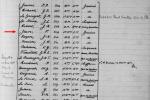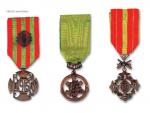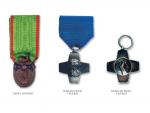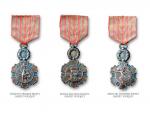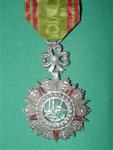-
Posts
402 -
Joined
-
Last visited
-
Days Won
2
Content Type
Profiles
Forums
Blogs
Gallery
Events
Store
Everything posted by Bison
-

DSM to a French seaman, WW1
Bison replied to Bison's topic in Great Britain: Orders, Gallantry, Campaign Medals
The Admiralty roll supporting my assumption of a double attribution: 1915 page : 1918 page where is also Premier Maitre MOZACH, who is the only French awarded twice with a clasp. But I suspect JEAN is the second, but with two medals. Please note that a replacement to a French is also noticed on the 1915 page above, therefore this second nomination is not a replacement, I suppose. -
Hello! An arrival in my collection last week. A DSM awarded to Maitre Canonnier Pierre JEAN of the Cuirassé Le Gaulois, who fought in the narrows of the Dardanelles in March 1915. Le Gaulois was sunk by a German UBoot on the 27 Dec 1917. Pierre JEAN is gazetted on the 23rd December 1915, and is registered in the Admiralty DSM roll under the number 509. But he is also registered in 1918 (without been gazetted, like all other foreign recipients) under the number 3341. My assumption is that Pierre Jean has been awarded twice the DSM, but with two medals instead of receiving a clasp, as it is usually mentioned in the roll for the other second attribution. Mistake of the administration? Please see below the roll where Pierre JEAN is incribed twice and the second time without clasp. I sincerely doubt that two P. Jean were Maitre Canonnier on Le Gaulois. I suppose the first attribution was for the disastrous attack of the Narrows on the 18 March 1915, and the second time consequently to the lost of the ship on the 27 December 1916. Another conclusion is that the DSM was issued inscribed to foreigners, unlike a wide spread idea and unlike other British decorations like the DCM or the MM. http://gmic.co.uk/uploads/monthly_01_2012/post-2068-0-28908400-1327946254.jpghttp://gmic.co.uk/uploads/monthly_01_2012/post-2068-0-36816400-1327946267.jpg
-
French skills cannot be horrible... Yours Bison
-
Hi Alf Two supplementary recommendations. Pay a visit to Jean Christophe Palthey, 1 rue Pierre Fontaine, 75009 PARIS, "Galerie Histoire et Curiosités" This is one of the best in Paris. You will be surprised by the treasures in it and the knowledge of Mr Palthey. http://www.phaleristic.com/ And don't miss "la Maison Platt", 49 rue de Richelieu, 75001 PARIS, another very good one. It is not very far from Le Palais Royal and Le Louvre des Antiquaires. http://maisonplatt.com/ When I go to Paris, my patrol itinerary goes always by these two mandatory way points, with le Musée de la Légion d'honneur and la galerie du Palais Royal. Another good but very expensive area is "Le Village Suisse", near the Ecole Militaire. Especially: "Aux Soldats d'Antan" http://www.auxsoldatsdantan.com/ Anyway, this tour is far more pleasant and enjoyable than to go to Les Puces where all the tourists and subsequent pickpockets are. Regards Bison
-
Hello Bill, From my perspective, this site is probably the most documented and relevant for French WWI medals, and may be for other countries too. http://www.medailles1914-1918.fr/medailles1914191.html Regards Bison
-
Hi Rob It is rare to find somebody interested in French punches, it is key for identification! The "M" is not for Monnaie de Paris but for "metal". The cornucopia in its right is the mark of the Paris Mint. This letter is only to indicate what kind of metal is used. We usually find besides the cornucopia : - a number, 1, 1* or 2 when it is silver (and sometimes a microscopic "A" on the cornucopia itself) - BR for BRONZE - BRFL or BRFLO for florentine bronze - MC or MCHORT for maillechort or argentan or nickel silver - METAL D or MD or M for other metals Hope that helps Regards Bison
-
Yes, a beautiful first type of the end of the XVIIth, beginning of the XVIIIth Century! This kind of crosses are very scarce because the medal was given back at the death of the knight. It was not an hereditary order. Moreover, this order was awarded for outstanding gallantry at war. A very scarce order, congratulations. Regards Bison
-
Hi The silver badge is for the graduated students of the French war college before WW2. After WW2, this badge has been replaced by a coin with the name and rank. I assume the unnamed gilt ones were designed for the staff and support unit to be worn in service dress. But this is just an assumption. Bison
-
Hi For the second hallmark, I think it is J+B, which is not a whisky company but the mark of Janvier & Berchot who manufactured a lot of Victory Medals. It could be also L[an anchor]C, for Léon Chalin who was another manufacturer. There are also some others... For the last one, as far as the signs are not printed, it is almost impossible to identify the manufacturer. Regards Bison
-
This is the "Mérite Social". This order, created in 1936, had three degrees (Knight, Officer and Commander). It was awarded to social workers, and especially the benevolent ones. It has been suppressed in 1963. Regards Bison
-
Hello There have been several projects for the Croix de Guerre. (Pictures from "La Marque du Courage", éditions LBM, Paris, 2005, ISBN 9 782915 347357) No one was selected... and there has been a huge discussion about the cross which seemed to be similar to the shape of the Iron Cross! Anticlerical politicians were also against a cross-like medal! Unanimity has been quickly made to use the same ribbon that the Sainte-Hélène Medal which was the campaign medal for the Veterans of the Army of Napoleon. These projects can be seen in the Légion d'honneur museum in Paris. Yours Bison
-
Hi everyone I see that the Légion d'honneur is not only a French internal passionate debate when it is awarded to surprising people... Bonaparte when he created this order in 1802 wanted to have a unified symbol for a unified nation with a unified elite under the Légion d'honneur order. Therefore, this award is dedicated to all outstanding merits and services; gallantry and poetry, artists, civil servants, lawyers and heroes etc. All are together, with the same badge, ribbon and degrees. It is sometimes surprising, but it is like that. Moreover it is worth to know that a non-French is just a 'recipient' of the Légion d'honneur and cannot be member of the Order. (I think there is an exception only for the Foreign Legion). Bison
-
As a French frog, I would like you to apologize for this offence. In France there are actually two paradoxes. The first one is that we are living longer than others thanks to the red wine; The second is that French people are absolutely fascinated by monarchy, Orders, decorations and medals but without knowing anything about them (but the wine!). I am very often disappointed when I watch a French film in which uniforms and medals are always coming from a third class operetta cloakroom, mixing ribbons and medallions. It's a pity, sorry, this is just a very bad ignorance. Sorry again Bison :cheeky:
-
Yes it is! Because there are beautiful and desirable, and also because the history attached to them is of utmost interest. All ODMs from the colonial period are considered as a must for a modest French collector like me... Aye Bison
-
For the Ouissam Alaouite, the model you are presenting is a post 1937 model, with an orange ribbon with two white stripes (this disposition was taken to avoid confusion with the red ribbon of the Légion d'honneur). In 1913, the first model was wearing the Quran sentence in the branches :"There is no god but God, and Muhammad is the messenger of God". This mention has been suppressed by the influence of the French Governor of the Protectorate, Marshall Lyautey.
-
1. 2. 3. 1. Ordre de l'Etoile Noire (Colonial Order, French Western Africa)) 2. Ordre du Nicham Iftikhar (Protectorate Order, Tunisia) 3. Ordre de l'Etoile d'Anjouan (Colonial Order, Comoros) Aye Bison
-
In fact and to be very precise on the wording there are seven French Colonial Orders : - Ordre du Dragon d'Annam (Indochina, to be short) - Ordre Royal du Cambodge (Cambodia) - Ordre de l'Etoile Noire (French Western Africa) - Ordre du Nichan El Anouar (Djibouti, Horn of Africa) - Ordre de l'Etoile d'Anjouan (Comoros Islands) The two others are from French 'Protectorates' but not actually considered as 'Colonies' because they were ruled by autonomous governorships. - Ordre du Ouissam Alaouite (Morocco) - Ordre du Nicham Iftikhar (Tunisia) Therefore there are at least three more reasons to love them... Cordialement Bison
-

Bronze BWM collection
Bison replied to Brian Wolfe's topic in Great Britain: Orders, Gallantry, Campaign Medals
Hello Rob Any news from your counterparts from medalcollectors? Regards Bison -
Hi Frankly, I don't know what is this medal. It is not a French official medal and I doubt it is French. There is a big mistake in the word "HONNEUR" which is written "HORNEUR"... may be a mix with HORREUR... Regards Bison
-
Hi Sometimes symbols have a meaning. In this case, the lightning ('l'éclair' in French)is very close in pronunciation with "LECLERE". That is the reason why some makers have chosen to have a sort of rebus in their marks. Regards Bison
-

Bronze BWM collection
Bison replied to Brian Wolfe's topic in Great Britain: Orders, Gallantry, Campaign Medals
Hi Rob Than you for your friendly and kind help. Regards Bison -

Bronze BWM collection
Bison replied to Brian Wolfe's topic in Great Britain: Orders, Gallantry, Campaign Medals
Thank you Rob! Unfortunately I cannot sign in to medalcollectors. When I try, this message appears: "Sorry. Registration has been disabled by the administrator." The access seems to be now restricted. Regards Bison -
Hi Direct from Afghanistan, I get this medal, identified as "Kunar Province Rebellion Medal". It seems to be in silver with a nice 'custom' local ribbon and pins. Is anybody able to say more about it? http://gmic.co.uk/uploads/monthly_03_2011/post-2068-0-75279600-1299875728.jpghttp://gmic.co.uk/uploads/monthly_03_2011/post-2068-0-15754200-1299875741.jpg Thanks in advance for your bright contributions... Regards Bison
-
Hi It is a crown of the King Louis-Philippe period. It is not a trefoil, but a "fleuron" (a sort of flower) in French. Usually, the crowns of this period don't have this kind of ornament at the top. This kind of crowns with that kind of cross-like "fleuron" have been reported sometimes. Regards Bison


